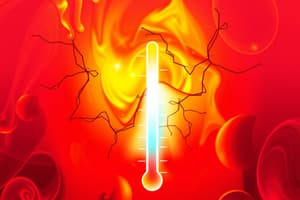Podcast
Questions and Answers
Match the following biotic factors with their definitions:
Match the following biotic factors with their definitions:
Temperature = A measure of the degree of hotness or coldness Sunlight = The primary source of energy for photosynthesis Water = Essential for all forms of life Soil/substrate = The surface layer of earth in which plants grow
Match the measurement instruments with their types:
Match the measurement instruments with their types:
Liquid thermometer = Uses liquid expansion to measure temperature Alcohol thermometer = Contains alcohol that expands with heat Mercury thermometer = Contains mercury in a glass tube Digital thermometer = Displays temperature readings electronically
Match the measurement scales with their freezing and boiling points:
Match the measurement scales with their freezing and boiling points:
Celsius = Freezes at 0° and boils at 100° Fahrenheit = Freezes at 32° and boils at 212° Kelvin = Freezes at 273.15 and boils at 373.15 Rankine = Freezes at 491.67° and boils at 671.67°
Match the temperature conversion equations with their correct conversions:
Match the temperature conversion equations with their correct conversions:
Match the example temperatures with their corresponding scales:
Match the example temperatures with their corresponding scales:
Match the type of thermometer with their primary features:
Match the type of thermometer with their primary features:
Match the following types of thermometers with their typical materials used:
Match the following types of thermometers with their typical materials used:
Match the biological significance of the following factors:
Match the biological significance of the following factors:
Flashcards are hidden until you start studying
Study Notes
Ecology
- Ecology is the study of an organism or organisms and their relationship to their surrounding physical, chemical, and biological environment.
- Biotic factors consist of the non-living components of an organism's environment, which includes:
- Temperature
- Sunlight
- Water
- Wind
- Pressure
- Soil/substrate
Measuring Temperature
- Temperature is a physical property of matter that expresses the concepts of hot and cold.
- Temperature is measured by thermometers, which can be calibrated to different scales.
- Most of the world uses the Celsius scale (°C).
- The United States uses the Fahrenheit scale (°F).
- The Kelvin scale (K) is used in some countries.
Converting Temperature Scales
- Fahrenheit to Celsius (°F to °C):
- Multiply the °F value by 9/5, then add 32.
- Celsius to Fahrenheit (°C to °F):
- Subtract 32 from the °C value, then multiply the result by 5/9.
- Celsius to Kelvin (°C to K):
- Add 273.15 to the °C value.
- Kelvin to Celsius (K to °C):
- Subtract 273.15 from the K value.
Examples of Temperature Conversion
- A temperature of 26°C is equivalent to 78.8°F.
- A temperature of 98.6°F is equivalent to 37°C.
- A temperature of 27°C is equivalent to 300K.
Types of Thermometers
- Liquid Thermometers are instruments with a sealed glass tube containing a column of liquid (e.g., mercury, alcohol) that expands and contracts with changes in temperature.
- Mercury-in-glass Thermometers and Alcohol Thermometers are common types of liquid thermometers.
Studying That Suits You
Use AI to generate personalized quizzes and flashcards to suit your learning preferences.




